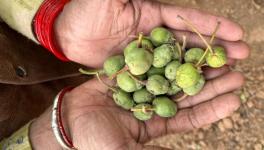Rare Phytoplasma Infecting and Killing Cherry Trees in Shimla
Representational Image. Image Courtesy: Wikimedia Commons
Delhi: The University of Horticulture and Forestry, in Nauni, Himachal Pradesh on Sunday said that cherry trees in the Baghi region in upper Shimla were being infected by a rare disease phytoplasma, The Tribune reported.
Director of Research at the university, Dr Sanjeev Chauhan told The Tribune that samples collected from the diseased trees were tested in the laboratory and through fluorescence microscopy, the presence of phytoplasma was confirmed. The phytoplasmas, a large group of plant-pathogenic, generally target stone fruits and spread through the insect leaf hopper.
A week back, the cherry farmers from the Baghi region informed the university about an unknown disease that had caused several cherry trees to dry up. After that, the university sent an expert team to examine the trees.
Information was also gathered from the cherry growers in the Kandyali area which has not been affected by the problem. Chauhan told the Sun Post that leaf yellowing, tattering, reddening and bronzing symptoms were observed in every diseased plant and the markers were found to be progressively spreading to the entire plant leading to its death, the Sun Post reported.
Dr Chauhan said the university would organise awareness camps in September and October to teach the farmers how to manage and control the disease, according to The Tribune.
The university has also released an advisory of practices that can be used in controlling the disease. Dr. Ramesh Kumar, director of the department of agriculture research and extension, said that Phytoplasma affects plant growth and leads them to wilt. It can be controlled by following the guidelines that the university has suggested, he told The Tribune.
The guidelines suggest drenching the plants with Jeevamrit 2-3 times in a weekly cycle, avoiding the use of bud sticks from symptomatic or affected trees, and instead the usage of only healthy planting material. It also advises completely getting rid of diseased twigs or branches of trees while pruning.
This is not the first instance of the disease being detected in the state. In 1997, phytoplasma affected peach trees in the Rajgarh area of the Sirmaur district. A farmer of Rajagarh, Prakash Chauta, told The Tribune that his village was famous as the peach bowl of Asia before the phytoplasma disease entered it and destroyed a large number of peach trees in the region.
Deepak Singha, the President of the Plum Growers’ Association, suggested the use of a pesticide spray with a specially curated schedule to battle the disease and said it should be made available at subsidized prices.
The university has also issued an advisory on management practices to control the disease. “The disease spreads slowly, giving farmers the time to control and curb it. It can be controlled if the growers follow the protocols that the university has suggested,” a scientist told The Tribune requesting anonymity.
Get the latest reports & analysis with people's perspective on Protests, movements & deep analytical videos, discussions of the current affairs in your Telegram app. Subscribe to NewsClick's Telegram channel & get Real-Time updates on stories, as they get published on our website.
























